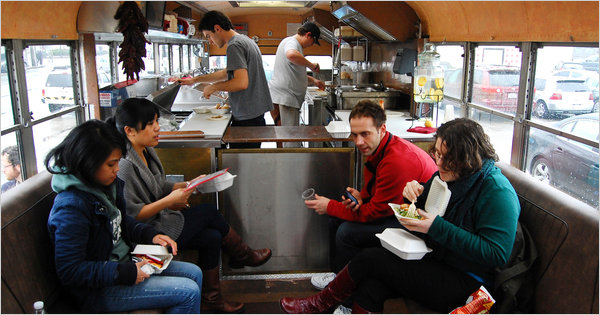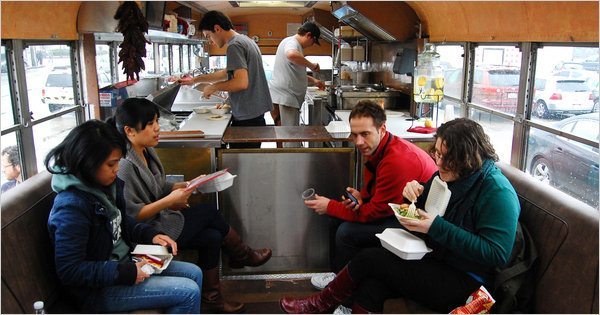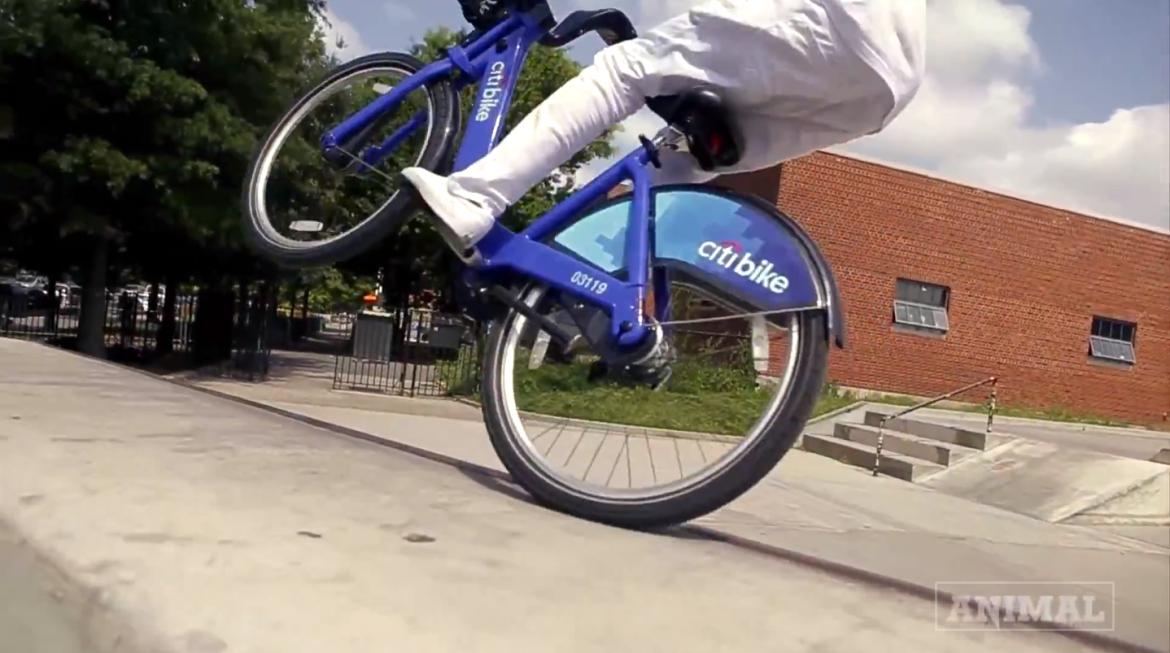The Vehicle of Street Food is Getting an Overhaul.
Great article – and hey, I like food. To think that one of these food service vehicles can cost upwards of $250,000.
By TODD LAPPIN
Published: January 14, 2011
LOS ANGELES — Chef Hugh Schick has cooked in some of the finest kitchens in the land. He took classes at the Culinary Institute of America, studied under the Italian food expert Marcella Hazan and served as a private chef for the likes of the writer Christopher Hitchens and the venture capitalist David Cowan.

But when Mr. Schick and his business partner, Blake Tally, decided to open Le Truc, a San Francisco “bustaurant,” with a gourmet kitchen and dedicated seating area inside a converted school bus, the two quickly learned that the kitchens in food trucks are very different from their brick-and-mortar equivalents.
“It’s basically like buying a trailer home,” Mr. Schick said. “You get a kitchen that’s not designed by a chef, but by an engineer who’s simply trying to figure out where to make things fit.”
As Mr. Schick and other chefs seek to take more exotic foods like agedashi tofu and foie gras torchon to the streets and sidewalks of San Francisco, Los Angeles and New York, they are demanding a host of upgrades to the traditional catering trucks, from teppanyaki grills to vertical chicken rotisseries.
And those who manufacture catering trucks are rushing to accommodate such special requests, which have rescued their industry from a recession-induced plunge in demand for the more traditional taco and hamburger trucks.
“We’re seeing demand for customization based on specific menus or food concepts, which may mean installing a pizza oven or a baking oven for cupcakes,” said Richard Gomez, customer sales engineer and plant controller at AA Cater Truck, the largest food truck manufacturer in the country. “There’s also a lot more emphasis on marketing and graphics. Trucks used to be just white, but now customers want to make their trucks look like celebrities.”
Founded in 1965, AA Cater Truck operates from a sprawling facility here in central Los Angeles, where the food trucks are designed, built, financed, sold and serviced.
A sister company, Hivco, a manufacturer of the delivery vehicles known as step vans, operates under the same roof. New vehicles arrive at the plant as stripped-down chassis assemblies that include wheels, a drivetrain, a steering wheel, a dashboard, a driver’s seat — and nothing more.
Hivco manufactures a specially reinforced body for each vehicle, while AA Cater Truck builds and installs standard interior fittings like griddles, fryers, refrigerators, sinks, water tanks, counters and food storage bins. A standard AA food truck sells for $124,000 new, but adding specialized kitchen equipment and appearance enhancements can push the cost up to $250,000.
The recent surge in gourmet food trucks came at a perfect time for the makers of food trucks. “The last three years were very tough on us,” Mr. Gomez said.
In Los Angeles, many food truck operators were driven out of business as their customers at construction and manufacturing sites lost their jobs. Orders for new trucks dried up and inventories of used and repossessed catering trucks piled up. For a while, AA had nearly 100 used food trucks for sale on its lot, compared with an average of 10 before the downturn.
But the downturn also hurt brick-and-mortar restaurants in Los Angeles, creating a pool of chefs and food professionals looking for work. Eventually, some of those unemployed people discovered the city’s stockpile of unemployed food trucks.
“Gourmet trucks are now our leading customer,” said Mr. Gomez. Over all, business is still down, from 26 trucks sold a month to six or seven now. But after shrinking from 150 employees to just 50, AA is hiring again.
In metropolitan areas, the economics of starting a gourmet food truck compare favorably to opening a brick-and-mortar restaurant, where $850,000 to $1.5 million in start-up capital is typically needed to secure a lease, renovate a space, equip a kitchen and hire staff, according to the restaurant consultant Clark Wolf. Going mobile reduces those costs to $200,000 or less, with additional savings possible if the owner can locate a used food truck in good condition for around $90,000.
“It’s a good business for people who can’t get traditional jobs and who are forced to be entrepreneurial,” said Josh Tang, co-founder and chief executive of Mobi Munch, a San Francisco start-up that plans to rent food trucks to established chefs and restaurateurs.
Over the next five years, Mobi Munch hopes to put 300 to 500 mobile food trucks made by AA on the streets nationwide. Mobi Munch will rent the trucks on a monthly basis, allowing entrepreneurs to explore the potential of what Mr. Tang calls “the mobile platform.” Each Mobi Munch truck will be a turnkey system, with a fully equipped kitchen and a cash register connected wirelessly to a central database.
Yet some food businesses, like Lake Street Creamery, require more customization. Gary Ferguson, a former Northwest Airlines pilot who co-founded the gourmet ice cream maker, had no need for the usual grills or steam tables.
Instead, he hired Armenco Cater Truck Manufacturing to outfit a used step-body truck with a custom freezer system and an Emery Thompson hard ice cream machine.
All the ice cream sold from the Lake Street Creamery truck is made inside the vehicle, and business is thriving. On a good day, it sells $11 worth of ice cream a minute, but volume is critical, and Mr. Ferguson said the key to success was to ensure the truck was tailored to the business.
“The food concept has to match the truck so you can serve quickly,” Mr. Ferguson said. “No one wants to wait for 20 minutes outside a truck.”
Like AA Cater Trucks, Armenco was also hit hard by the recession. “I thought we might have to shut down,” said Arthur Djahani, whose family owns and runs Armenco. Because of the gourmet trend, however, Armenco’s small manufacturing facility in Sun Valley, Calif., is now busy.
Amid the recent surge of work, one of Armenco’s hardest projects was the bus for Le Truc. Apart from the challenge of installing a full kitchen in the back of a school bus, the bus itself required substantial reinforcement. The kitchen had to be not only functional, but also stylish since customers in the seating area would see it. That meant adding flourishes like copper-surfaced fittings and full-length skylights.
Looking ahead, both Mr. Djahani and Mr. Tang see more established restaurants getting into the mobile business. Armenco, for example, has already built a truck for the Sizzler chain.
“For existing restaurants, it’s a very natural extension of their business,” Mr. Tang said. “They already have the kitchen and the staff.”
Mr. Djahani also expects more demand for kitchens in a wider range of vehicles, the better to stand out. “We now get a lot of requests for different kinds of platforms that might offer more space — things like buses and Airstream trailers,” he said.



